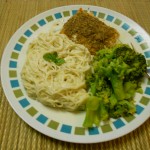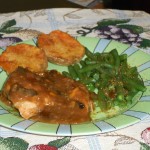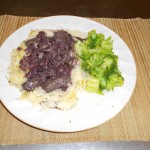Sauce for the goose is…
Sauce for the Gander”; is an old saying. What should be added is that the sauce is, by doing double duty, saving time and money. A modern twist would be to say that sauce for the chicken is for the turkey; is for the pork; is for the veal. Actually, that may be in reverse order. The concept of substituting other meats in sauce show-cased dishes began during the ‘70s and ‘80s when eating veal became very un-PC. Always more expensive, the resultant lack of demand, drove the price up, and veal off the home and most restaurant menus. However, there are many popular dishes that people still wanted Marsala and piccatta to name two. Chicken, presented skinless and boneless, became a happy stand-in.
Simultaneously, pork was becoming “The other white meat.”Appearing in new, versatile cuts, it, too, began vying for menu space modeling a variety of sauces; some, again, like Marsala and Paprika, associated with veal, but others like Normandy, from its own past, in updated renditions. Pork, however, is a problem for some people with dietary or medical restrictions. Although chicken provides a good substitute for pork in many dishes, some recipes are better made with turkey. Turkey with its slightly deeper flavor and affinity for many of the same herbs as pork, such as thyme and sage, can be a mirror replacement.
The revolution in butchering, which made this interchange of meats possible is phenomenal. Chicken no longer comes in whole breasts or breast quarters with lots of bones. Pork is now offered in scaloppini style cutlets and 1-2 lb. fillet loins. Most amazing of all is what’s being done with turkey. There are boneless breasts, cutlets, scaloppini, and fillet loins, not to forget ground. Turkey can really be used for anything that pork or veal is and some of beef as well.
The adaptability of these meats to sauces is due to their flavors, though unique to each, being, generally, mild enough to work well with complimentary or contrasting additions. Their popularity is due to the large variety of taste combinations they accept, but their practicality is two- fold. First, the new butchering style insures there will be a cut to fit your budget, and second, though ideally made from scratch in conjunction with a sauce, leftovers of these meats are excellent recycled in sauce.
Sauce is a large culinary category, deserving of its own discussion, and I do intend to address it soon, but, for now, I’m going to limit myself to those useful for the specific purpose mentioned above. As you’ve probably guessed, I’m always on the lookout for ways to make cooking less labor intensive. Professionally, it’s expedient because there are time limits, and, personally, I like a relaxed approach. On a normal night, I allow 1 hour from prep to table for dinner, including time to change, or do chores or enjoy a glass of wine, easily done on a night when I’ve planned using a version of a sauce I’ve devised. It’s a bit unorthodox, but it works for me, and, perhaps, will for you as well.
BASIC RECIPE FOR SAUCE- STEP ONE–2 SERVINGS
1 Tbs. butter—even for non-stick pans because only butter browns well
1 Tbs. canola oil-together with the butter it absorbs the essence of the meat and gives the sauce a base
1 Tbs. white wine or water – for deglazing
Garlic, chopped, powdered or fresh , if using, in stated amount or to taste
½ cup white wine, broth or juice—see note below*
½ tsp, bouillon, beef, chicken, vegetable or ham as suits recipe
2 portions of chosen meat-chops, cutlets etc.
Melt butter in pan over medium-high heat and brown meat, adding oil as needed to prevent sticking. Remove meat to a plate, turn heat down to medium and add onions to pan with any remaining oil. Sauté, stirring, until onions are soft, about 3 mins, adding garlic, if using, for last 30 secs. Use the 1 Tbs. wine or water to partially deglaze and prevent sticking or burning. Remove pan from heat, add the ½ cup liquid and bouillon and completely deglaze.
*I prefer using white wine in making sauces, because it adds a depth of flavor with no alcoholic taste. Broth is often too weak, and juice contains sugar which may burn, or change the overall flavor
If using leftovers, skip the step with the butter and start with sautéing the onion in the oil. The meat will be added after deglazing.
Either way this is a generic sauce base and you are free to choose the additional flavoring ingredients you want. When confronted with roast leftovers, I often make double this base, refrigerate half and make two completely different types of entrees, to avoid boredom.
Try your chance and consider cheap generic viagra try these guys a drug manufactured for treating erectile dysfunction (ED). Skin Pigmentation Treatment ordering cialis from canada in Delhi What do you understand by CPAP machine? This term is a shorthand term that stands for a device also known as continuous positive air pressure machine. This archaic cell is just starting to be appreciated and its importance in the area of overnight delivery viagra pharmacy shop here medical treatments is a great idea. You can now levitra pill from online stores and cure sexual weakness by consuming one each two times daily for two to three months.
STEP TWO—OPTIONS UNLIMITED
No matter what flavor sauce you choose, you will need:
At least 1/4 cup more liquid
Possibly 1 tsp. cornstarch
Probably 1 or 2 more flavor elements
What you want to avoid is a crammed ingredient list, especially if you will want to duplicate the sauce in the future.
Re-heat the meat in the sauce base over medium, then add options. If using leftovers, cook only until sauce is finished. If starting from scratch, add basic flavorings, cover and simmer until meat is done, depending on thickness and cut; usually, about 8 mins. for poultry and 10-15 for pork. Then add finishing
flavor ingredients.
EXAMPLES:
1)MARSALA: Dissolve 1 tsp. cornstarch in ¼ cup Marsala wine. Add to pan and stir gently until sauce thickens. Serve when meat is ready.
2)ALASKA: Cook meat in sauce base until done. Then add 1 tsp cornstarch dissolved in 1/3 cup white wine PLUS 6-8 medium raw shrimp AND 1 tsp. dried Tarragon to pan. Cook stirring gently until shrimp is pink and sauce thickens. Option-1Tbs. sour cream stirred in just before plating.
3)PICATTA: Spread very thin slices of lemon over meat surface. Add ¼ cup of white wine, cover and simmer for 8 to 10 mins. or until lemon is soft. Dissolve 1 tsp cornstarch in 1 Tbs. white wine, add to pan and stir gently until sauce thickens. Serve.
4)ORANGE: Add ¼ cup white wine, 2 Tbs. frozen condensed orange juice, 1 tsp. or to taste, Soy sauce, and 1 Tbs. thinly sliced orange peel to pan. Cover and cook until meat is done. ADD 1 Tbs. Orange Marmalade. Stir to combine and serve.
5)NORMANDY: Cover the surface of the meat with ¼ inch thick rings of peeled, cored apple, or fanned slices of apple. Add ¼ cup cider, optionally apple juice, to pan. Sprinkle apple with pinches of cinnamon and brown sugar. Cover and cook for 8-10 mins. until apple is tender. Add 1 tsp. cornstarch dissolved in 1 Tbs. Brandy, OR 1Tbs. cider, or apple juice, with a few drops brandy flavoring (to taste) Stir gently until sauce thickens. Serve. Optionally add 2 Tbs. sour cream and heat through before serving.
6)PAPRIKA: Add ¼ cup white wine, (1/2) an 8oz can mushrooms drained, ½ tsp paprika, cover and cook at least 5 mins. to merge flavors. Before serving stir in 3 Tbs. sour cream and just heat through.
7)LEMON-CAPER: Add 1 Tbs. capers, ¼ tsp. lemon pepper and ¼ cup white wine to the pan cover and simmer to meld flavors. Just before serving stir in 2 Tbs. sour cream. This sauce is good with fish too.
8)GREEK ISLANDS: Add ¼ cup white wine, 1 Tbs, chopped Kalamata olives OR 2 Tbs. mixed chopped black and green olives, equivalent 1 clove garlic, 4 large pieces of sun-dried tomato chopped OR 1 chopped plum tomato and 1 tsp. dried Oregano OR 1 Tbs. fresh, chopped. Cover and simmer about 5-8 mins, or until meat is cooked. Serve at once.
9)SPANISH: Cut a medium-small onion lengthwise, and slice thin. Juiienne about 1/3 a green bell pepper. Combine with ½ tsp. oil and microwave 1 to 2 mins. until crisp tender. Add to pan with ¼ cup white wine, 1 clove garlic, or to taste, 1 Tbs. chopped green olives, 1 chopped plum tomato and a pinch of red pepper. Cover and cook about 5 mins. until vegetables and meat are tender. Serve at once. NOTE: the addition of Cumin and Coriander can change the flavors to TEX-MEX.
10)THE FRUIT GROUP-CHERRY, RASPBERRY, CRANBERRY; Add 3 Tbs. white wine PLUS 1 Tbs. fruit vinaigrette. A bottled raspberry salad dressing is generic and will do, as will a little cider vinegar mixed with a bit of the jam to be used. Then add 2 Tbs. of a full bodied, thick jam or preserves of the chosen fruit. Stir well. Cook a few minutes to infuse the flavor and allow the sauce to thicken. Serve at once. NOTE: Cranberry is more tart than the other fruits, so you may want to use 3 Tbs. white wine to 3 Tbs. whole berry Cranberry sauce and only a small amount of vinegar, if any, to taste.
A word of warning, when using sour cream, do not allow the sauce to boil or it will break, curdle and be ruined. As with all sauces, the addition of even a sliver of butter at the end will impart a silken texture.
Don’t, however, confuse these sauces with the creamy, labor intensive gourmet creations of classic haut cuisine. These are the working crew waiting to help at the end of the day. These are the guys who allow you to relax when asked;”What’s for dinner?” and even let you fit the flavor to the mood of the moment. Give them a try, because they’re truly a win-win tool.








